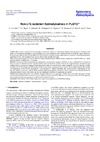Identificador persistente para citar o vincular este elemento:
https://accedacris.ulpgc.es/jspui/handle/10553/57926
| Título: | Non-LTE radiation hydrodynamics in PLUTO | Autores/as: | Colombo, S. Orlando, S. Rodríguez, R. Espinosa, G. González, M. Stehlé, C. Peres, G. |
Clasificación UNESCO: | 221113 Interacción de la radiación con los sólidos | Palabras clave: | Radiation Opacity Flux-Limited Diffusion X-Ray-Emission Optically Thin, et al. |
Fecha de publicación: | 2019 | Publicación seriada: | Astronomy & astrophysics (Print) | Resumen: | Modeling the dynamics of most astrophysical structures requires an adequate description of the interaction of radiation and matter. Several numerical (magneto-) hydrodynamics codes were upgraded with a radiation module to fulfill this request. However, those that used either the flux-limited diffusion (FLD) or the M1 radiation moment approaches are restricted to local thermodynamic equilibrium (LTE). This assumption may not be valid in some astrophysical cases. Aims. We present an upgraded version of the LTE radiation-hydrodynamics (RHD) module implemented in the PLUTO code, which we have extended to handle non-LTE regimes. Methods. Starting from the general frequency-integrated comoving-frame equations of RHD, we have justified all the assumptions that were made to obtain the non-LTE equations that are implemented in the module under the FLD approximation. An operator-split method with two substeps was employed: The hydrodynamics part was solved with an explicit method by the solvers that are currently available in PLUTO, and the non-LTE radiation diffusion and energy exchange part was solved with an implicit method. The module was implemented in the PLUTO environment. It uses databases of radiative quantities that can be provided independently by the user: The radiative power loss, and the Planck and Rosseland mean opacities. In our case, these quantities were determined from a collisional-radiative steady-state model, and they are tabulated as functions of temperature and density. Results. Our implementation has been validated through different tests, in particular, radiative shock tests. The agreement with the semi-analytical solutions (when available) is good, with a maximum error of 7%. Moreover, we have proved that a non-LTE approach is of paramount importance to properly model accretion shock structures. Conclusion. Our radiation FLD module represents a step toward a general non-LTE RHD modeling. | URI: | https://accedacris.ulpgc.es/handle/10553/57926 | ISSN: | 0004-6361 | DOI: | 10.1051/0004-6361/201935991 | Fuente: | Astronomy and Astrophysics [ISSN 0004-6361], v. 631 (A41) |
| Colección: | Artículos |
Citas SCOPUSTM
4
actualizado el 08-jun-2025
Citas de WEB OF SCIENCETM
Citations
4
actualizado el 08-jun-2025
Visitas
140
actualizado el 07-sep-2024
Descargas
138
actualizado el 07-sep-2024
Google ScholarTM
Verifica
Altmetric
Comparte
Exporta metadatos
Los elementos en ULPGC accedaCRIS están protegidos por derechos de autor con todos los derechos reservados, a menos que se indique lo contrario.
